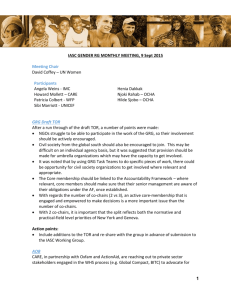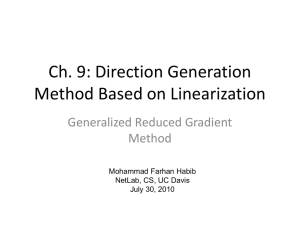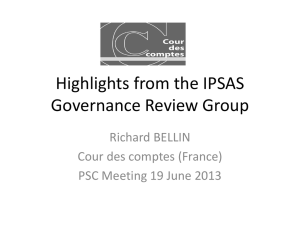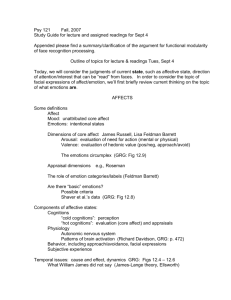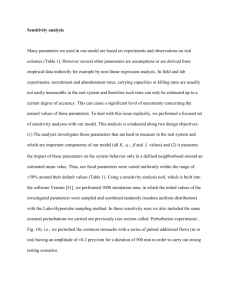Vision Study Guide
advertisement
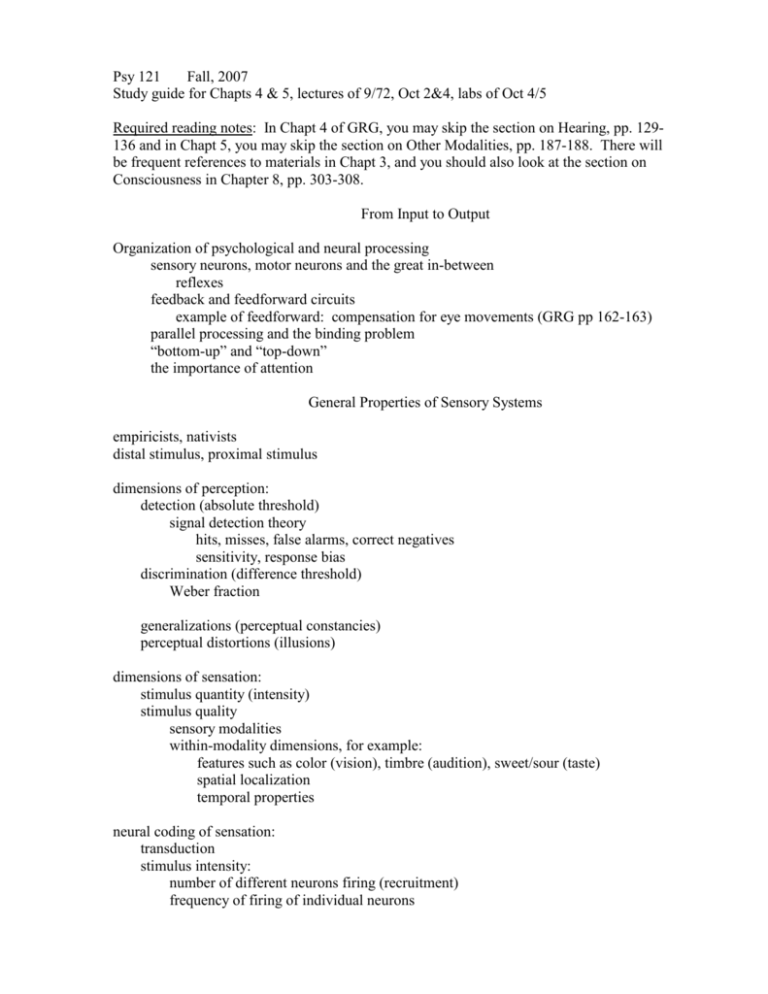
Psy 121 Fall, 2007 Study guide for Chapts 4 & 5, lectures of 9/72, Oct 2&4, labs of Oct 4/5 Required reading notes: In Chapt 4 of GRG, you may skip the section on Hearing, pp. 129136 and in Chapt 5, you may skip the section on Other Modalities, pp. 187-188. There will be frequent references to materials in Chapt 3, and you should also look at the section on Consciousness in Chapter 8, pp. 303-308. From Input to Output Organization of psychological and neural processing sensory neurons, motor neurons and the great in-between reflexes feedback and feedforward circuits example of feedforward: compensation for eye movements (GRG pp 162-163) parallel processing and the binding problem “bottom-up” and “top-down” the importance of attention General Properties of Sensory Systems empiricists, nativists distal stimulus, proximal stimulus dimensions of perception: detection (absolute threshold) signal detection theory hits, misses, false alarms, correct negatives sensitivity, response bias discrimination (difference threshold) Weber fraction generalizations (perceptual constancies) perceptual distortions (illusions) dimensions of sensation: stimulus quantity (intensity) stimulus quality sensory modalities within-modality dimensions, for example: features such as color (vision), timbre (audition), sweet/sour (taste) spatial localization temporal properties neural coding of sensation: transduction stimulus intensity: number of different neurons firing (recruitment) frequency of firing of individual neurons Psy 121, Study Guide for lectures and reading on vision (cont.) 2 stimulus quality: which neurons fire (neuronal specificity), for example: modality specific neurons topographic (spatially organized) projections pattern theory temporal properties: phasic/tonic responses synchrony among neurons Vision properties of light: corresponding psychological dimension intensity: brightness wavelength(s): hue and saturation spatial origin: spatial location receptive fields of single neurons what are they (GRG p.180) how are they "mapped"? (GRG Fig 4.31) the visual system (GRG Fig 5.41) structure of the eye (GRG Fig 4.12) the retina (structure of retinal microcircuits, GRG Fig 4.13) optic nerves, optic chiasm, optic tracts lateralization in the visual system thalamic relay: the lateral geniculate nucleus (LGN) visual cortex primary visual cortex (V1) further processing areas dorsal and ventral pathways, parallel processing (GRG Fig 5.42) processing in the retina photoreceptors: rods and cones (duplex theory of vision: ways in which rods & cones differ) chemical transduction: photopigments (visual pigments) rhodopsin in rods 3 cone opsins (trichromatic color vision, primary colors) spectral sensitivity curves peripheral vs foveal vision horizontal cells: lateral inhibition (GRG Fig 4.20) ganglion cells (GRG p. 180) P-cells (parvo cells): center-surround receptive fields (GRG Fig 4.32) spatial discrimination color opponency (opponent process color vision, complementary colors) GRG Fig 4.28 M-cells (magno cells): movement sensitivity Important point in lecture: an analysis of neuronal specificity and pattern theory in the retina perceptual phenomena (retinal) absolute (detection) thresholds Psy 121, Study Guide for lectures and reading on vision (cont.) 3 the rhodopsin spectral sensitivity curve the cone spectral sensitivity curves (GRG Fig 4.24) brightness contrast (e.g., GRG Figs 4.16 - 4.19) and lateral inhibition negative color afterimage (GRG Fig 4.26): adaptation and color opponency simultaneous color contrast: color opponency and lateral inhibition (GRG Fig 4.25) II. processing in primary visual cortex (area V1, striate cortex) retinotopic projection (spatial selectivity) “feature detectors” orientation selectivity (GRG Fig 4.23) movement sensitivity: directional selectivity (GRG p. 161) binocular receptive fields (basis of binocular disparity sensitivity, GRG p.157) spectral sensitivity cortical columns (modules) neuropsychology: blindsight (GRG p. 305) III. beyond V1, the "ventral stream": form detection and color processing (the "what" system) area V4: color inferior temporal cortex: “geon” detectors, object detectors e.g., face cells in the FFA (note fMRI findings in GRG pp. 306-307) “grandmother cells” and the binding problem neural synchrony, gamma band oscillations form/object recognition "feature nets" and simultaneous multiple constraint satisfaction (GRG pp. 176-178) priming effects (GRG p. 177) visual segregation or perceptual parsing grouping principles (laws of perceptual organization): proximity, similarity, good continuation, closure, coherent motion figure/ground higher-order invariants unconscious inference perceptual phenomena perceptual constancies brightness constancy size constancy shape constancies position constancy illusions subjective contours (GRG Fig 5.19) geometrical illusions (e.g., Muller-Lyer illusion) moon illusion Ponzo illusion (GRG Fig 5.35) ambiguous figures (GRG Figs 5.28 – 5.30) impossible figures (GRG Fig 5.44) Psy 121, Study Guide for lectures and reading on vision (cont.) 4 neuropsychology (Chapt 3): agnosias IV. Beyond V1, the "dorsal stream": motion processing, depth perception (the "where" or "how" system) the parietal cortex area V5 (MT): motion detection Newsome’s microstimulation experiments spatial frames of reference perceptual phenomena motion aftereffects (adaptation) apparent (or stroboscopic) movement (GRG Fig 5.10) induced motion (GRG Fig 5.12) depth cues (GRG pp. 157-163) binocular disparity (retinal disparity) pictorial cues (monocular depth cues) linear perspective, relative size, interposition, texture gradients light & shadow motion parallax, optic flow neuropsychology: neglect syndrome (Chapter 3) visual attention involuntary (reflexive, exogenous) and voluntary (endogenous) orienting visual search feature-driven pop out serial search for feature conjunctions illusory conjunctions attention and perceptual organization: ambiguous figures
